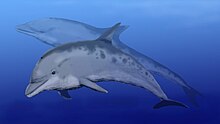Kentriodon
| Kentriodon Temporal range:
| |
|---|---|

| |
| K. pernix skeleton | |
| Scientific classification | |
| Domain: | Eukaryota |
| Kingdom: | Animalia |
| Phylum: | Chordata |
| Class: | Mammalia |
| Order: | Artiodactyla |
| Infraorder: | Cetacea |
| Family: | †Kentriodontidae |
| Genus: | †Kentriodon Kellogg, 1927 |
| Species[1] | |
| |
| Synonyms | |
| |
Kentriodon is an extinct genus of toothed whale related to modern-day dolphins. Fossils have been found in North America, Europe and Japan.[1] Several species have been described.
Description
[edit]
Kentriodon was the most diverse of all the kentriodontids, which are represented by seventeen described genera. These were small to medium-sized odontocetes with largely symmetrical skulls, and thought likely to include ancestors of some modern species. Kentriodon is also the oldest described kentriodontid genus, reported from the Late Oligocene to the Middle Miocene.
Kentriodontines ate small fish and other nectonic organisms; they are thought to have been active echolocators, and might have formed pods. The diversity, morphology and distribution of fossils appear parallel to some modern species.
Species
[edit]- Kentriodon pernix Kellogg, 1927 (type)[2]
- Kentriodon fuchsii (Brandt, 1873)[3]
- Kentriodon hobetsu Ichishima, 1995[4]
- Kentriodon obscurus (Kellogg, 1931)[5]
- Kentriodon schneideri Whitmore and Kaltenbach, 2008[6]
- Kentriodon diusinus Salinas-Márquez, Barnes, Flores-Trujillo, Aranda-Manteca, 2014[7]
- Kentriodon hoepfneri Kazár & Hampe, 2014[8]
- Kentriodon nakajimai Kimura & Hasegawa, 2019[9]
- Kentriodon sugawarai Guo & Kohno, 2021[1]
See also
[edit]References
[edit]- ^ a b c Guo, Z., & Kohno, N. (2021). A new kentriodontid (Cetacea: Odontoceti) from the early to middle Miocene of the western North Pacific and a revision of kentriodontid phylogeny. PeerJ, 9, e10945. https://doi.org/10.7717/peerj.10945
- ^ R. Kellogg. 1927. Kentriodon pernix, a Miocene porpoise from Maryland. Proceedings of the United States National Museum 69(19):1-14
- ^ J. F. Brandt. 1873. Untersuchungen über die fossilen und subfossilen cetaceen Europa's. Mémoires de L'Académie Impériale des Sciences de Saint-Petersbourg, Series 7 20(1):1-372
- ^ H. Ichishima. 1995. A new fossil kentriodontid dolphin (Cetacea; Kentriodontidae) from the Middle Miocene Takinoue Formation, Hokkaido, Japan. The Island Arc 3:473-485
- ^ R. Kellogg. 1931. Pelagic mammals of the Temblor Formation of the Kern River region, California. Proceedings of the California Academy of Sciences 19(12):217-397
- ^ F. C. Whitmore and J. A. Kaltenbach. 2008. Neogene Cetacea of the Lee Creek Phosphate Mine, North Carolina. Virginia Museum of Natural History Special Publication 14:181-269
- ^ F. M. Salinas-Marquez, L. G. Barnes, J. G. Flores-Trujillo and F. J. Aranda-Manteca. 2014. Una especie de delfín fósil (Cetacea; Delphinoidea; Kentriodontoidae) del Mioceno Medio de Baja California. Boletin de la Sociedad Geologica Mexicana 66(1):145-164
- ^ Emese Kazár and Oliver Hampe (2014). "A new species of Kentriodon (Mammalia, Odontoceti, Delphinoidea) from the middle/late Miocene of Groß Pampau (Schleswig-Holstein, North Germany)". Journal of Vertebrate Paleontology 34 (5): 1216–1230. doi:10.1080/02724634.2014.857347.
- ^ Kimura, T., & Hasegawa, Y. (2019). A new species of Kentriodon (Cetacea, Odontoceti, Kentriodontidae) from the Miocene of Japan. Journal of Vertebrate Paleontology, 39(1), e1566739. https://doi.org/10.1080/02724634.2019.1566739
Further reading
[edit]- Encyclopedia of Marine Mammals, Perrin, Würsig, Thewissen
- The Evolution of Whales, Adapted from National Geographic, November 2001
- Kentriodontidae
- Prehistoric cetacean genera
- Oligocene cetaceans
- Miocene cetaceans
- Miocene mammals of Europe
- Oligocene mammals of Europe
- Miocene mammals of Asia
- Oligocene mammals of Asia
- Miocene mammals of North America
- Oligocene mammals of North America
- Miocene mammals of South America
- Neogene Argentina
- Fossils of Argentina
- Neogene Peru
- Fossils of Peru
- Fossil taxa described in 1927
